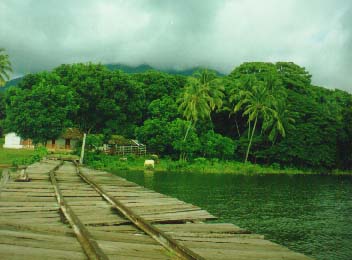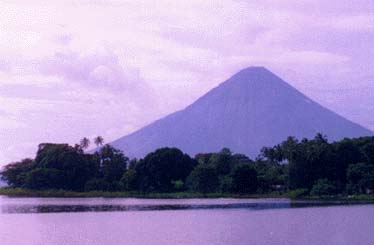 DAYS
6,7,8 : Parque Nacional Masaya and Granada
DAYS
6,7,8 : Parque Nacional Masaya and Granada
| Coordinates | 11 to 15 degrees north latitude, 83 to 88 degrees west latitude |
| Area | 130,000 Sq Km |
| Lakes | 10,000 Sq Km |
| Population | 4,400,000; 65% urban, 50% of Nicaraguans are under 15 |
| Religion | 90% Roman Catholic, not state supported. |
| National tree | Madroño (Calllycophyllum candiddisimum) |
| National Bird | Guardabarranco (Eumonota sp.) |
| National Flower | Sacuanjoche (Plumería rubra acutifolia) |
| National sport | Baseball (the other CA countries play mostly soccer |
 Nicaragua is in the middle of Central America, bordered by the
Pacific Ocean and the Caribbean; by Honduras to the north and
Costa Rica to the south. In a region of small countries,
Nicaragua qualifies as a giant extending over 51,000 square
miles. Of all the countries in Central America, Nicaragua is
the one that has kept most of its native forest, a full 30 %
of its total area.
Nicaragua is in the middle of Central America, bordered by the
Pacific Ocean and the Caribbean; by Honduras to the north and
Costa Rica to the south. In a region of small countries,
Nicaragua qualifies as a giant extending over 51,000 square
miles. Of all the countries in Central America, Nicaragua is
the one that has kept most of its native forest, a full 30 %
of its total area.Lake Nicaragua and Lake Managua cover forty-nine hundred square miles and the chain of 25 volcanoes that dammed them off make the most striking scenery in Central America. Lake Managua is forty five miles long by twenty wide at its northern end. Rising from the water on a short peninsula is a majestic volcano with a marvelous name: Momotombo, Victor Hugo's "Bald and Nude Colossus", and "The Father of Fire and Stone" of the great Nicaraguan poet Rubén Darío. Immense and beautiful as it is, Lake Managua is a trifle compared to the inland sea south of it Lake Nicaragua which is one hundred miles long and forty five miles wide-the largest body of fresh water between Lake Michigan and Lake Titicaca.
We will depart from La Suerte at the end of each summer course on our 16 -passenger air-conditioned van (1993 Ford) to Río Sapoa.The Río Sapoa port is located 5 Km. fromthe CR border and it is one of Rivas' port on Lake Nicaragua, where we will take our boat, The Thomas Belt (20-30 minute boat ride), to Ometepe Island. Ometepe means "two mountains", and that is exactly what the island consist of: extinct Maderas (1394 meters), and perfectly shaped, steaming Concepción (1610 meters). The Maderas is draped in a furry carpet of tropical cloud forest. After being at La Suerte for 26 days, our legs should be ready to hike Parque Nacional Volcán Maderas, culminating in a crater lake surrounded by cloud forest; several hot springs are near the route to the summit. After hiking Maderas, we will return to the Ometepe Biological Field Station and rest for a day, kayaking Lake Nicaragua, (the station will provide you with free use of kayaks), the following day we will hikef to the Maderas waterfall which is at a hiking distance from the station. The drainage of the crater forms an underground river that drains on the western side of the volcano forming the San Ramón waterfall.
On the main land again
 DAYS
6,7,8 : Parque Nacional Masaya and Granada
DAYS
6,7,8 : Parque Nacional Masaya and Granada
Masaya Volcano National Park features two volcanoes: Masaya and Nindiri which grew in stages. Their multiple orifices were called by the Spanish La Boca del Infierno ("The Mouth of Hell"). Masaya National Park was founded in 1974, extends over 54 square km, and was the first national park established in Nicaragua. We will visit the museum of volcanology, etnology, folklore and ecology; hike Sendero de Los Coyotes ("Coyote Trail" ), which runs 5 km through seasonally dry tropical forest. We will pass dry lava rivers that were thrown out of the volcano in a series of eruptions that started in 1670. Its rock formations will take us to the shores of Lake Masaya (Laguna de Masaya). Granada, which is on the shore of Lake Nicaragua (Lago Cocibolca), is one of the oldest cities in the Americas and was founded in 1524 by Francisco Hernandez de Cordoba. We will move around the city in horse-drawn carriages, and visit the Museum of Anthropology and History of Granada, a few of the cathedrals, convents and churches.
DAYS 9 : (tentative)Camping at Chocacente National Reserve on the Pacific coast near the Costa Rican Border. This is one of the few known nesting sites in the world of the olive ridleys. 10,000 to 15,000 ("Arribadas") nest there every year. Leatherbacks, Pacific green turtles and hawksbills also nest at these sites.
Day 10: Depart from Managua to your home country
Cost: $575.00 USD per person
INCLUDED: Round trip from Costa Rica to Nicaragua; all lodging; all land and water transportation within Nicaragua; all food; cooks for our camping trip to the beaches (three meals per day, including non-alcoholic beverages); entrance to all parks and museums; bus driver; the services of a bilingual guide; guide's and driver's expenses, camping equipment. Free kayaks and bikes rentals will be provided by Ometepe Biological Field Station, if you plan to kayak please bring with you a certified life vest, you will not be allowed to use the kayaks or bikes without a life vest or helmet.
NOT INCLUDED: Airport departure taxes in Costa Rica ($17.00 USD per person as of 03/97); personal equipment; extras in hotels (laundry, phone calls, room service) and gratuities; lodging in Managua; on the last day of the trip (10th day).
PAYMENT POLICY: The funds (575.00 USD) must be forward along with the course tuition (1350.00 USD)
CANCELLATION POLICY: For reimbursements on the prepaid Nicaragua trip you need to cancel 45 days prior to the class date. Trip payment is transferable to a future date. .
Note: The group will be departed from Managua Nicaragua.
| Departure dates to Nicaragua | Departure date from Nicaragua to your home country |
| June 19, 1998 | June 29, 1998 |
| July 17, 1998 | July 27, 1998 |
| August 14, 1998 | August 24, 1998 |
Additional Photos from Nicaragua Trip
* The Registration fee is required to reserve a space in the course. Students judged by La Suerte not suitable to take the course or students that end up on the waiting list (space is limited) will have their registration fee refunded. Once you are accepted into our program, the regristration fee will not be refunded but is transferable to future courses.
In addition to tuition charges, please also consider the following to determine the total cost of participation:
Transportation and travele arrangements: To insure orderly arrival at the site, we work with one travel agency to handle all travel. You will receive specific travel details after your acceptance. You are responsible for passport, to and from San Jose, Costa Rica or Managua, Nicaragua.
Students are welcome to take multiple courses at the two stations, consecutive sessions do not overlap.
Optional trips: In addition to, and separate from the optional Nicaragua trip at the end of the course, there may be an optional trip during the course to one of the nearby national parks, or other sites. Unfortunately, these are not cheap. So if you do plan to participate, plan to bring at least $100.00 more than the amount already suggested. If we do arrange a trip, we will do so once we arrive, and again, this is optional.
Clothing and Equipment: La Suerte/Ometepe will provide you with food, housing and transportation from San José/Managua to La Suerte/Ometepe Biological Field Station (3 hours bus ride) and 45 minutes on a ferry if you are going to Ometepe. You are responsible for personal gear, including backpacks, clothing, and all items in the equipment list.
Physical Examination and Medical Insurance: You are required to have a physical exam and active medical insurance during the period fo the field school.
Course Credit: You should check with your advisor/sponsor/registrar before going into the field. Many schools award credit on a case by case basis and most shcools will charge you for the credits you are awarded from your home institution.
Review: This page provides links to information on the country of Nicaragua. Subjects covered include maps, history, travel information, GDP growth, geography, economic data, trade data, government information, head of state and cabinet, constitution, and more.
CORNELIUS VANDERBILT Bibliography
